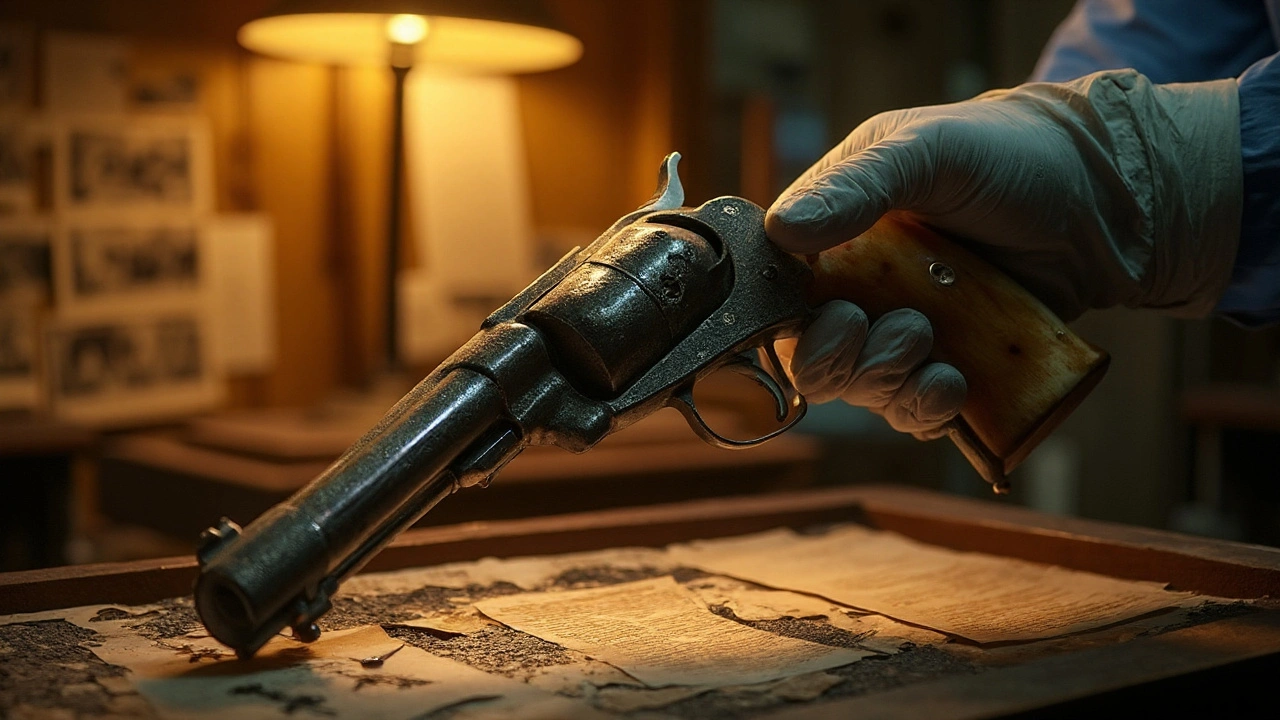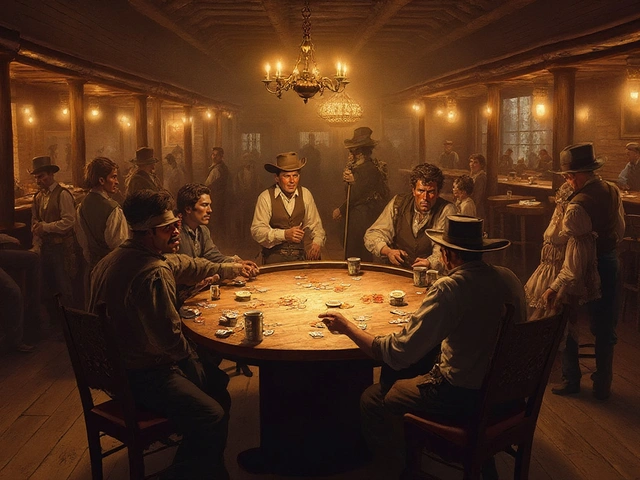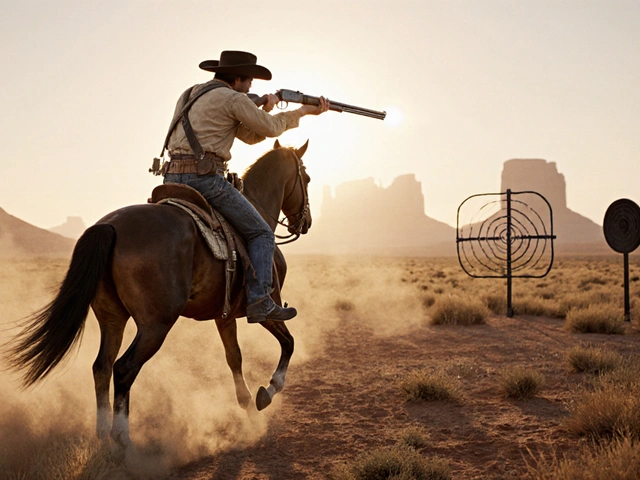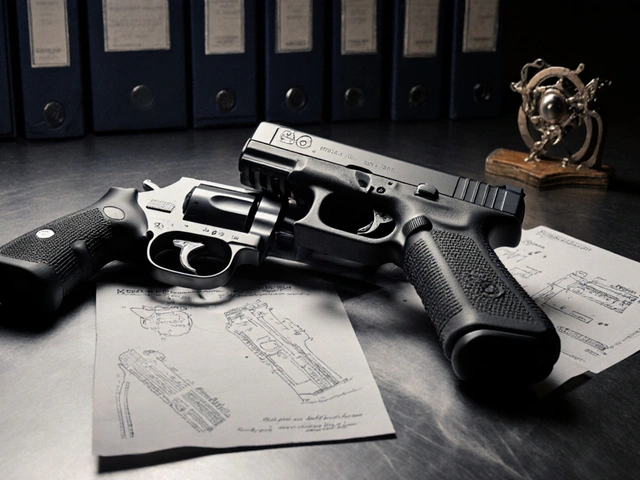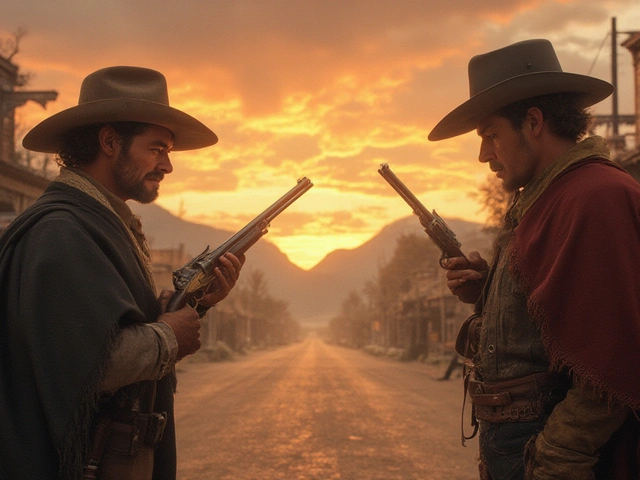Short answer? There wasn't just one. Wyatt Earp used more than one handgun across different years and towns-most likely a Colt Single Action Army in .45 Colt or .44-40 and, earlier, a Smith & Wesson Model 3 top-break in .44. The long-barreled “Buntline Special” you’ve seen in movies is almost certainly a later myth. If that’s all you needed, you’re set. If you want the receipts-factory records, court testimony, and what serious historians actually agree on-keep going.
TL;DR: What gun did Wyatt Earp use?
- The reliable picture is a mix: a Colt Single Action Army (7.5-inch “Cavalry” length) in .45 Colt or .44-40; and, earlier, a Smith & Wesson Model 3 top-break in .44 (American/Russian/New Model No. 3 era).
- At the O.K. Corral fight (1881), he likely carried a standard-length Colt revolver; Doc Holliday notably started with a short double-barrel shotgun.
- During the 1882 Vendetta Ride, Wyatt famously used a short, double-barrel 10-gauge shotgun to kill Curly Bill Brocius, then transitioned to his revolver.
- The “Buntline Special” (a super-long-barreled Colt) comes from a 1931 biography and doesn’t match factory records or period usage. Treat it as legend.
- Provenance claims for specific Earp guns sold at auction exist, but authenticity is hotly debated; documentation is everything.
Jobs you’re trying to get done right now:
- Get a clear, no-nonsense answer to “what gun did Wyatt Earp use?”
- Separate movie myths from what records support.
- See which models, calibers, and barrel lengths match each phase of his life.
- Learn how historians verify an Earp gun claim.
- Skim a quick checklist and a tight FAQ to settle lingering questions.
How historians actually answer the Wyatt Earp gun question
The reason this question is slippery is simple: Wyatt Earp worked in different towns (Wichita, Dodge City, Tombstone), across different years, under different laws, and with changing technology and ammo availability. Lawmen weren’t locked to a single sidearm, and a lot of what people “know” about Earp came from a colorful 1931 biography by Stuart Lake that mixed truth with Hollywood-ready storytelling.
When you strip out the hype, a practical picture emerges. In the mid-to-late 1870s on the cattle towns circuit (Wichita and Dodge City), Earp likely favored a Smith & Wesson Model 3 top-break revolver in .44. Why that platform? It opened upward, kicked cases out, and reloaded fast-ideal for a peace officer who wanted quick administrative reloads after an arrest or a scuffle. Firearms historians have long pointed to the Model 3 as a lawman’s workhorse of the period, and Wyatt moved in that world. You’ll find this stance from writers like Garry James and in museums’ curator notes; it’s also consistent with what we know of ammo and availability on the frontier.
By Tombstone (1880-1882), the Colt Single Action Army (SAA) in .45 Colt or .44-40 was everywhere. The .44-40 Colt-stamped “Frontier Six Shooter”-shared ammo with the popular Winchester Model 1873 rifle, a strong practical draw. Historians such as Casey Tefertiller (Wyatt Earp: The Life Behind the Legend, 1997) argue the everyday, service-length SAA is the most credible fit for Wyatt’s Tombstone sidearm. At the O.K. Corral fight, witness testimony confirms pistols and a shotgun in play, but nobody gave a factory-perfect recital of model numbers and serials in court. So we read the room: what was standard for a lawman, what was on belts in that exact year, and what the best sources discredit.
Which brings us to the “Buntline Special.” The idea that dime novelist Ned Buntline gifted Wyatt and other lawmen 10- to 12-inch barreled Colts shows up in Stuart Lake’s 1931 book. It’s a brilliant movie prop. It’s not supported by Colt factory letters naming those men as recipients, and the shipping records researchers cite don’t tie long-barreled guns to Wyatt. The late 19th century did see some long-barrel SAAs shipped, but connecting those specific guns to Earp is where the story falls apart. Tefertiller and other serious historians treat the Buntline tale as a legend.
What about shotguns and rifles? Wyatt, Virgil, and Doc weren’t shy about scatterguns when the job called for it. A short, double-barrel 10-gauge “coach gun” fits the era and the tactics, and Wyatt’s killing of Curly Bill Brocius at Iron Springs (1882) is almost always described with a short 10-gauge followed by a switch to a revolver as the fight unfolded. Exact maker? Less certain. The point is, shotguns were core lawman tools, not just pistols.
Finally, auctions. Every few years, a firearm with Earp’s name surfaces with family provenance. In 2014, a Colt SAA attributed to Wyatt (often described as a U.S. Cavalry .45) sold for a headline price. Curators and historians immediately debated the chain of custody and documents. That’s the pattern with “Earp guns”: unless you can marry factory letters, dated photos, period affidavits, and logical ownership chains, skepticism is healthy.
So, in plain language: Earp used a standard-length Colt SAA in Tombstone, likely in .45 Colt or .44-40. Earlier and between gigs, a Smith & Wesson Model 3 in .44 would’ve been right at home on his belt. The super-long Buntline? Fun, famous, and almost certainly fiction.
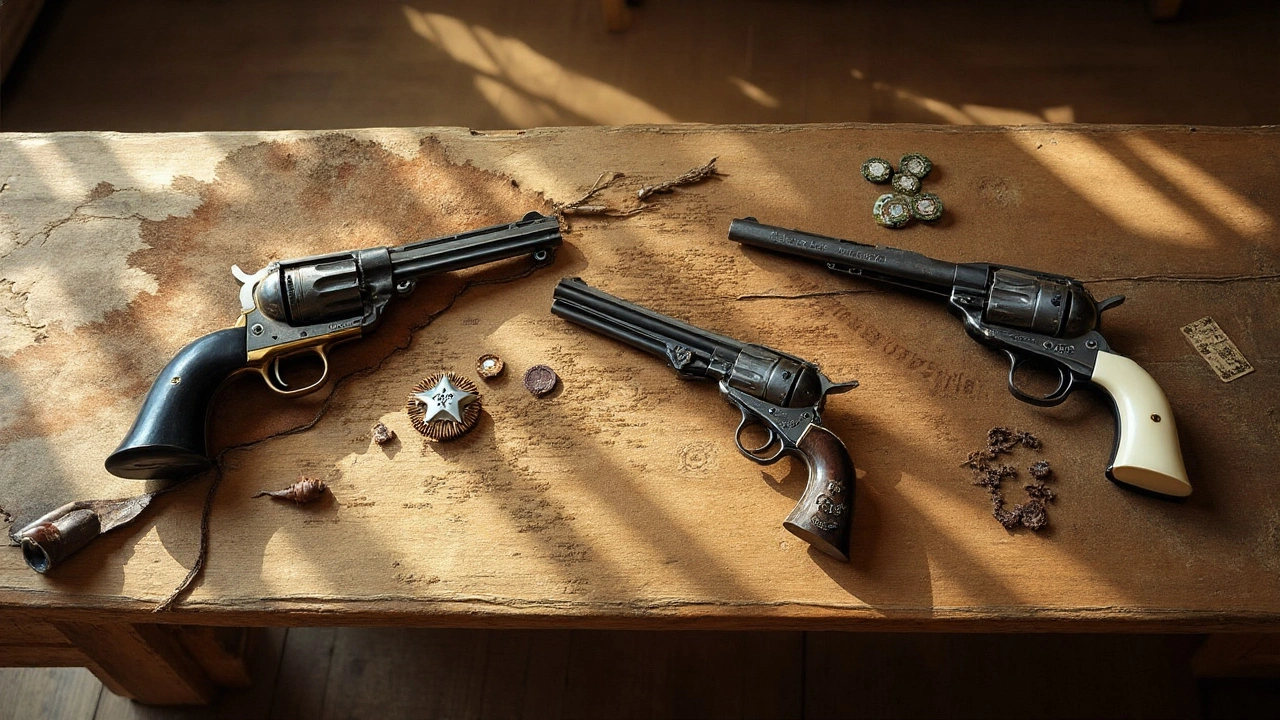
From claim to confidence: verify an Earp gun in 6 steps
Want to assess a specific claim-maybe for research, collecting, or content? Use this workflow. It mirrors how professional historians and curators sort signal from noise.
- Anchor the date and place. Was the gun allegedly used in Wichita (1874-75), Dodge City (1876-78), or Tombstone (1880-82), or during the 1882 Vendetta? The likely platform shifts by year and town.
- Check the platform against period norms. For 1870s cattle towns, Smith & Wesson Model 3 in .44 (American/Russian/New Model) is plausible. For Tombstone, Colt SAA 7.5-inch in .45 Colt or .44-40 fits. “Odd” platforms aren’t impossible, but your burden of proof rises fast.
- Demand paperwork. Factory letters (Colt or S&W) that include serial numbers and shipment destinations; U.S. Army surplus records for Cavalry SAAs; hardware store or dealer ledgers; law agency memos. Named recipients are gold; vague invoices are weak.
- Trace provenance without gaps. Who owned the gun after Wyatt? Which family members? Are there dated receipts, wills, notarized statements? A single 20th-century affidavit isn’t enough. You want a chain that makes sense year by year.
- Test the story against testimony. The Spicer hearing records after the O.K. Corral shooting, period newspapers (Tombstone Epitaph, Dodge City Times), and sworn statements describe who fired what type of weapon even if they don’t list models. If the claim contradicts those descriptions, that’s a red flag.
- Look for independent expert opinions. Reputable historians (e.g., Casey Tefertiller) and museum curators should be able to say “yes, plausible” or “no, that conflicts with documented patterns.” Auction houses have incentives; outside scholars are your ballast.
Pro tips:
- If a claim leans on the “Buntline Special,” ask for the exact Colt factory letter tying a long-barrel SAA to Wyatt by name. You won’t get it.
- Barrel length matters. The classic 7.5-inch “Cavalry” SAA shows up endlessly in the 1880-82 timeframe. A 4.75-inch “Civilian” barrel isn’t impossible, but check holster photos and descriptions.
- Ammo logic helps. In 1881 Arizona, .44-40 (for rifle and revolver) was common and practical; .45 Colt is also well attested. Weird calibers need strong proof.
- Photographs rarely show serials, but they do show holster length and grip shape. Use them to cross-check the story.
Examples, comparisons, and what actually fits
Let’s line up the contenders you read about and see how they stack against time, place, and evidence. This is where the movie gun falls away and the working cop’s kit steps forward.
Wyatt Earp gun candidates, by type and era:
- Smith & Wesson Model 3 (American/Russian/New Model No. 3), .44 caliber family. Strengths: fast reload, common on 1870s belts, period-correct for Wichita/Dodge. Evidence: consistent with lawman usage and ammo availability; widely supported by historians as plausible for Wyatt’s early years.
- Colt Single Action Army, 7.5-inch “Cavalry” length, .45 Colt or .44-40. Strengths: rugged, ubiquitous by 1880-82, excellent stopping power; .44-40 pairs with Winchester ’73. Evidence: fits Tombstone timeframe; witness accounts align with a standard-length Colt on lawmen.
- Double-barrel “coach gun,” 10-gauge, short barrels. Role: fight-starter at close range. Evidence: widely cited in accounts of Wyatt’s killing of Curly Bill (1882) and in frontier law enforcement generally.
- Long-barrel “Buntline Special” Colt. Strengths: cinematic. Evidence: originating mainly with Stuart Lake (1931); lacks confirmatory factory documentation; treated as legend by modern researchers.
Here’s a quick reference comparing specifications and the documentary temperature around them:
| Firearm | Typical Caliber | Barrel Length | Era/Use | Evidence Level | Notes |
|---|---|---|---|---|---|
| S&W Model 3 (American/Russian/New Model) | .44 S&W American / .44 Russian | 6.5-8 inches (varied) | Wichita/Dodge City (1870s) | Strongly plausible | Top-break, fast reload; favored by many lawmen of the period. |
| Colt Single Action Army (Cavalry) | .45 Colt or .44-40 | 7.5 inches | Tombstone (1880-82) | Highly plausible | .44-40 “Frontier Six Shooter” pairs with Winchester ’73 ammo. |
| Double-barrel shotgun (“coach gun”) | 10-gauge | ~18-22 inches (short) | Vendetta Ride (1882) | Plausible to likely | Common lawman tool; repeatedly cited in Iron Springs fight accounts. |
| “Buntline Special” Colt | .45 Colt (claimed) | 10-12 inches (claimed) | Popular lore post-1931 | Weak/legendary | Stuart Lake story; lacks corroborating factory documentation. |
What did contemporaries carry? Plenty of colleagues in the same towns used the same workmanlike kit: SAAs, S&W Model 3s, and short shotguns. If you’re picturing a lawman’s holster in Tombstone in late 1881, think a full-length revolver that fills the holster, not a freakishly long barrel dragging near the knee.
About calibers, quickly:
- .45 Colt delivered real punch and was tied to U.S. Army contracts. It’s right at home on a lawman’s belt in 1880-82.
- .44-40 did double duty with the Winchester ’73, which mattered when supply chains were patchy. A revolver and rifle sharing ammo is not just “neat”-it’s practical.
- .44 S&W American and .44 Russian lived mostly in S&W top-breaks; that maps well onto the 1870s phase of Wyatt’s career.
Why the Buntline story keeps surviving: it’s cinematic, it makes Wyatt larger than life, and it gives prop masters a signature silhouette. But the hard-paper trail-Colt letters, shipping ledgers tying long barrels to named recipients-doesn’t back it. Historians like Casey Tefertiller have gone over this ground for decades; the consensus hasn’t shifted.

Checklist, cheat-sheet, and mini‑FAQ
Quick checklist to sanity-check any “Wyatt Earp gun” claim:
- Era matches platform: 1870s = S&W Model 3 plausible; 1880-82 = Colt SAA plausible; 1882 Vendetta = short 10-ga shotgun plausible.
- Barrel length makes sense: 7.5-inch SAA is the workhorse; exotic lengths demand strong documents.
- Caliber fits context: .45 Colt or .44-40 in Tombstone; .44 S&W family earlier.
- Provenance is continuous: named owners, dated papers, credible transfers.
- Factory/supporting records exist: Colt/S&W letters, dealer ledgers, or law agency paperwork.
- Independent experts agree: look for published historians and curators, not just auction catalog copy.
Decision tip: If a claim relies on a single family affidavit made decades after the events, treat it as interesting but not dispositive. Stack it against factory letters and period documents. If those don’t show up, keep your wallet in your pocket.
Mini‑FAQ
- Did Wyatt Earp carry a Buntline Special? Almost certainly not. The story traces to a 1931 biography by Stuart Lake. Colt records don’t tie a long-barrel “Buntline” to Wyatt by name.
- So what was he most likely packing at the O.K. Corral? A standard 7.5-inch Colt Single Action Army, chambered in .45 Colt or .44-40. Doc Holliday started the fight with a short double-barrel shotgun before switching to a revolver.
- Which gun did he use to kill Curly Bill? Accounts point to a short, double-barrel 10-gauge shotgun to open the fight, followed by his revolver as the skirmish moved.
- Did he prefer Smith & Wesson or Colt? Both, depending on the year. The S&W Model 3 top-break fits his 1870s lawman years; the Colt SAA was king by Tombstone.
- Was his Colt nickel-plated? Some lawmen liked nickel finishes for corrosion resistance; period photos and descriptions aren’t definitive for Wyatt’s specific gun at the O.K. Corral. Nickel is plausible, not proven.
- Where is Wyatt Earp’s gun now? Multiple guns with claimed Earp provenance exist in private hands and museums. Authenticity varies. Without unbroken documentation, treat each as “attributed,” not “proven.”
- What caliber is “Frontier Six Shooter”? That barrel marking denotes .44-40 in the Colt SAA line-popular with men who also ran a Winchester ’73 rifle.
Next steps and troubleshooting paths:
- If you’re a casual reader: remember this simple rule-Colt SAA in Tombstone, S&W Model 3 earlier, and a short 10-gauge when things got close and ugly.
- If you’re a collector vetting a piece: get factory letters first, then scrutinize provenance year by year. Ask a neutral historian for a written opinion that references specific records (shipping dates, serial blocks, dealer names).
- If you’re writing or filming: ditch the Buntline prop unless your story leans into mythmaking. A 7.5-inch SAA reads as authentic on screen; pairing it with a Winchester ’73 and a short coach gun screams “Tombstone, 1881.”
- If you’re teaching: use the Earp/Buntline debate to show students how to separate legend from primary sources. Compare a Stuart Lake excerpt with a factory letter summary and the Spicer hearing testimony highlights.
Sources worth knowing (for credibility, not for clicking): Stuart N. Lake’s Wyatt Earp (1931) for the origin of the Buntline myth; Casey Tefertiller’s Wyatt Earp: The Life Behind the Legend (1997) for modern scholarship; period newspapers like the Tombstone Epitaph and Dodge City Times; the Spicer hearing records following the 1881 gunfight; factory documentation from Colt and Smith & Wesson; and museum curators’ notes from institutions that have handled claimed Earp firearms. When those align, you get confidence. When they don’t, you’ve got a great campfire story-and a reason to keep your skepticism handy.

